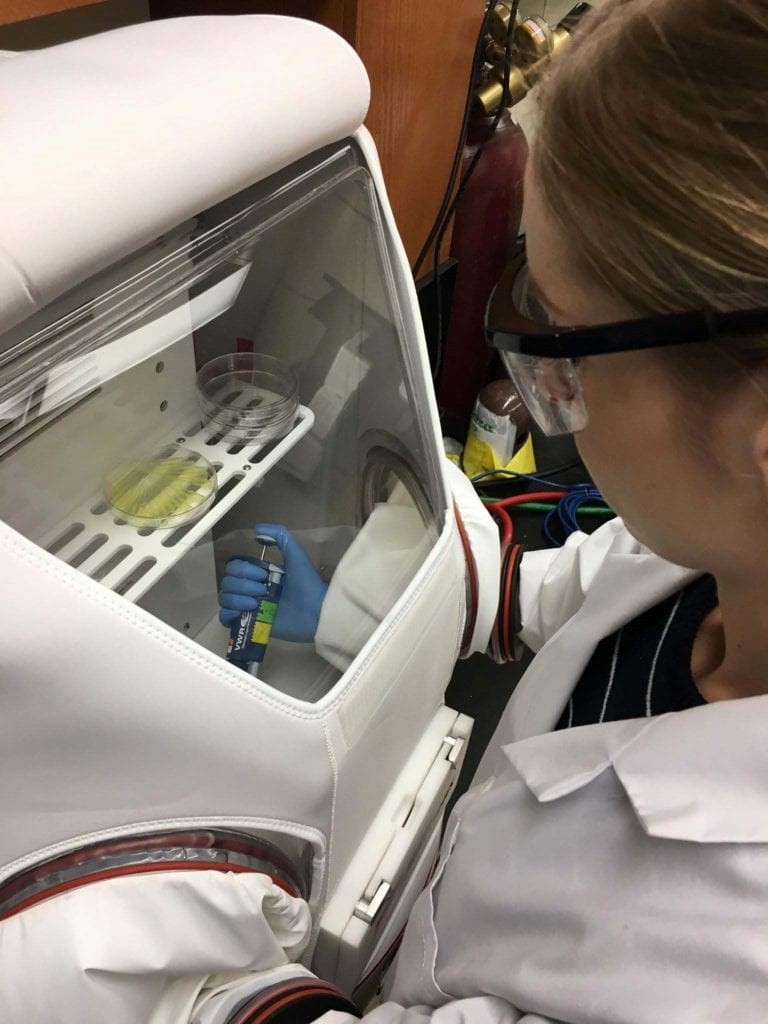Investigating the role of metabolism in human induced pluripotent stem cell generation

This team of researchers in the Biology Department at Western University are investigating metabolic ways to increase efficiency of reprogramming adult cells to iPSCs.
Embryonic stem cells are pluripotent, which means they can turn into any cell type found in the adult body and are therefore critical for human development 1
Stem cells show great promise in the field of regenerative medicine where, following injury or illness, they can be transplanted to repair tissue. The challenge with human embryonic stem cells, however, is that their application is limited by ethical concerns and potential rejection by the recipient’s immune system. Just over a decade ago, pioneering experiments by Dr. Shinya Yamanaka’s lab in Japan revealed a way to reprogram differentiated adult cells back into pluripotent stem cells by over expressing transcription factors responsible for pluripotency1. The resulting induced pluripotent stem cells (iPSCs) are functionally similar to embryonic stem cells but do not face the same ethical and immune response concerns. For these reasons, iPSCs have the potential to advance our knowledge of early human development and to provide a cell source for regenerative medicine. Unfortunately, the efficiency of reprogramming adult cells to iPSCs is very low2. Studies conducted in the Cumming lab in the Biology Department at Western University have shown that manipulating cellular metabolism may promote increased reprogramming efficiency.
PhD student Alexandra Kozlov is examining the effect of restricting human skin cells to different metabolite fuel sources, and how these fuels alter the cellular metabolic state.While adult cells, such as skin cells, preferentially metabolize nutrients by oxidative phosphorylation (OXPHOS), stem cells prefer to use glycolysis3. During reprogramming, cells undergo a metabolic switch from oxidative phosphorylation (OXPHOS) to glycolysis.

More importantly, several studies have shown that promoting glycolysis can increase reprogramming efficiency4. Hypoxia-inducible factor 1-alpha (HIF-1a) is a key glycolysis-promoting transcription factor that has been shown to contribute to mediating the metabolic switch from OXPHOS to glycolysis during reprogramming5. While HIF-1a is readily activated in a low oxygen (hypoxic) environment, it normally degrades rapidly under atmospheric oxygen (normoxic) levels. In human skin cells cultured under different defined metabolite conditions under normoxic and hypoxic conditions using the HypoxyLab from Oxford Optronix, and HIF-1a protein levels were measured. The HypoxyLab permits the maintenance and treatment of cell cultures in a sterile hypoxic environment in which the temperature and humidity are kept constant. This controlled environment improves the accuracy, reproducibility and physiological relevance of experimental analyses. Data collected using the HypoxyLab revealed that under certain defined metabolite conditions, HIF-1a was activated even under normoxic conditions. These findings indicate that culturing human skin cells in defined metabolite medium will promote metabolic alterations that favour the metabolic switch from OXPHOS to glycolysis.
Cited References:
- Takahashi, K., Tanabe, K., Ohnuki, M., Narita, M, Ichisaka, T., Tomoda, K., and Yamanaka, S. 2007. Induction of pluripotent stem cells from adult human fibroblasts by defined factors. Cell. 131:861-872.
- Rao, M.S. and Malik, N. 2012. Assessing iPSC reprogramming methods for their suitability in translational medicine. J. Cell. Biochem. 113:3061-3068.
- Zhang, J., Nuebel, E., Daley, G.Q., Koehler, C.M., and Teitell, M.A. 2012. Metabolic regulation in pluripotent stem cells during reprogramming and self-renewal. Cell Stem Cell. 11:589-585.
- Folmes, C.D.L., Nelson, T.J., Martinez-Fernandez, A., Arrell, D.K., Lindor, J.Z., Dzeja, P.P., Ikeda, Y., Perez-Terzic, C., and Terzic, A. 2011. Somatic oxidative bioenergetics transitions into pluripotency-dependent glycolysis to facilitate nuclear reprogramming. Cell. Metab. 14:264-271.
- Hawkins, K.E., Joy, S., Dalhove, J.M.K.M., Kotiaids, V.N., Fernandez, E., Fitzpatrick, L.M., Whiteford, J.R., King, P.J., Bolanos, J.P., Duchen, M.R. et al. 2016. Nrf2 orchestrated the metabolic shift during induced pluripotent stem cell reprogramming. Cell. Rep. 14:1883-1891.